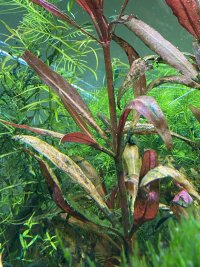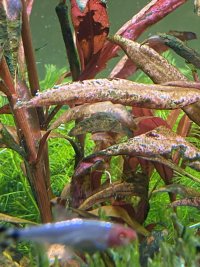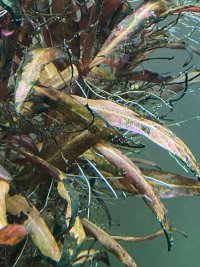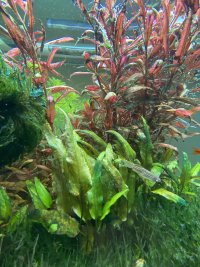Haha I see where you’re coming from but I’m pretty patient- I waited for over a year for the tank to be delivered due to covid and was completely okay with that lol. A couple of weeks here and there is nothing in the grand scheme of things.Perhaps not the best methodology, it'll probably prolong the agony. If you follow anyone's advice on this best to follow Clive's @ceg4048
-
You are viewing the forum as a Guest, please login (you can use your Facebook, Twitter, Google or Microsoft account to login) or register using this link: Log in or Sign Up
You are using an out of date browser. It may not display this or other websites correctly.
You should upgrade or use an alternative browser.
You should upgrade or use an alternative browser.
Worsening algae after starting EI dosing
- Thread starter Animallover
- Start date
Yes there are holes pointing downwards haha- I thought it was a great configuration when setting it up as the flow is going everywhere but after reading your post that makes a lot of sense that it’s just going straight down to the sediment. So yes I can easily twist the holes back so they are facing the front of the tank.Hi,
OK, that configuration is even less effective than I thought. If I read that diagram correctly you have the spraybar holes pointing down? That only then sends the flow to the back part of the sediment. Then there is the corner unit which is sending it's flow to the longest possible distance in the tank, which is the hypotenuse of the triangle formed by the two tank sides and the diagonal. The energy peters out and goes nowhere. This was OK when the plants were smaller and had less mass, but as they grow and demand more of everything this distribution method fails. This has nothing to do with your fertilization method and everything to do with flow/distribution. The fact that your algal blooms began 11 days after switching to EI is merely coincidence. In fact, it's possible that the plants grew more rapidly after you began dosing EI and that increased mass then blocked the flow. When switching to EI you never have to worry about gradual implementation. Just get on with it.
The problem you mention with the FX6 angled outlets is the most vexing and may require it to be modified. It it were up to me I would cut off the outlets and run the hose into a fabricated spraybar. This can be any rigid plastic tubing of the right size (25mm?) with holes drilled. It may be possible to block off one of the spuds and to point the open spud so that it's pointing towards the front glass, but I don't know if that increases the flow from that single open spud. It's worth a try though and you can then move it away from the corner and place it half way between the end of the spraybar and the left wall. In fact the spraybar assembly needs to be shifted more towards the center and away from the right wall. Both the section labeled "3" as well as the section labeled "4" should point forward towards the front glass. With the spraybar assembly moved over away from the wall and the single "duckbill" in operation (or a DIY spraybar fabricated) you'll be moving a lot more water in a coherent fashion. The water will move towards the front glass and then will naturally be deflected down towards the sediment. When it contacts the sediment it will then be deflected towards the rear when it will make contact with the plants . CO2 will remain in solution longer and the plants will have more contact time with the nutrients.
We will exclude anything that proves to be less fruitful. I don't get your argument: On the one hand you acknowledge that EI was developed long ago. The guy who developed it understood exactly that NH3/NH4 is problematic and can cause problems. This was never a hidden fact. This is exactly why he chose an innocuous Nitrogen compound KNO3 and specifically avoided Ammonium Nitrate and Urea, which has been in use in all commercial fertilizers for a hundred years. In fact, that's why we have environmental problems with fertilizer runoff from the land. Ammonium compounds get dumped into waterways at an uncontrolled rate and causes algal blooms. Barr chose wisely, knowing that you could not get into trouble dosing NO3, even knowing that NH3/NH4 deliver quadruple the amount of Nitrogen. HE CHOSE TO AVOID NH3/NH4.
This choice is not a result of being outdated or old fashion. It's actually just the reverse.
Your argument demonstrates your lack of general and historical knowledge. The fact that the fancy commercial products use NH3/NH4/Urea is not the result of some modern technology. It is a result of those brands maximizing their profits using an old and outdated chemical that has proven to be an environmental nightmare years ago. Ammonium salts are CHEAP and are therefore more effective than NO3 salts, but cause more problems when used by knuckleheads. You are a typical victim of propaganda and you do not study all the facts in order to gain perspective. You look at a pretty bottle with shiny liquids and immediately assume that it must be modern, when the product is actually 100 years old.
Who cares? This is more argumentative nonsense. We know what we are referring to and why, as I have already explained. I don't even care about these chelators. I don't use them because they are more money sent down the drain. Use them to your hearts content if it makes you feel more "modern".
It might be better for the OP to follow the advice of folks that have been successfully giving advice that works for years - even though the advice is old and outdated the advice is still more pertinent than following the "modern" trends of putting lipstick on a pig.
Cheers,
The fx6 has got annoying outflow nozzles and for now sounds like a lot of hassle to try and fix. I think I will just try facing both nozzles as forward as they go in the direction of the front glass and see what the response is. I personally don’t know how I’d block off one of the spuds so think this option will have to do for now.
I also have a lid with pre cut holes in them so I can so easily put move the outlets from each corner to the centre. The only way is like you’re saying via making a DIY extension on each side. I actually just remembered why one of the FX6 nozzles is facing towards the long side as it is directly spraying pressure on too of the CO2 diffuser so I thought it might help with getting the gas CO2 to stay in water as the gas bubbles stay longer under water as opposed to just going to the top? Is my logic correct or did I just make that all up lol.
What I'm saying is that I do not care what chelator is in my nutrient products. Hobbyists do not need to fret as much as they do about which chelator to use. As soon as you put the nutrient products in the water the plants start to absorb them. There are both passive and active methods used by the plant leaves to absorb nutrients. Within an hour the plants have taken up as much Iron and other micronutrients that they need. It doesn't really matter if much of it precipitate out of solution because they have taken their fill and even so, the micronutrient precipitates settle into the sediment where the plant roots have other chemical mechanisms to absorb these micronutrients if needed.Clive, I didn't understand this quote, so you are saying that you don't use any fertilizer such as CSM+B ? Which is made with EDTA chelate? I thought you have a sticky thread about this on the front page in the fertilizer dosing section. Again the argument is not even about or related to weather spending the money on chelate or not or weather spending the money on these are throwing the money in the drain. Am just curious now what you use now that is not made with chelation? Please answer so others can benefit from it.
What I'm saying therefore is that EI is first and foremost a method of defeating the commercial brands that charge an arm and a leg for basic nutrients that farmers have been using to grow produce for a hundred years. We can buy the very cheapest raw powders and the micronutrient powders can use the most basic and cheapest chelators and this will be completely transparent to the plants. You do not need to spend extra money for exotic chelators because the plants really do not care. I buy my nutrient products from the cheapest and most reliable e-bay sellers. That failing that I can go to the nearest nursery and buy the stuff in bulk.
Well, again, the reason you see it as a flaw is due to lack of understanding of the nutrient mechanism. Yes, if GSA is due to a PO4 deficiency (it can also be due to CO2 deficiency and any combination thereof) then you need to add more PO4. There is no calculation of exactly how much PO4 is needed for the plant to recover. It would be a tall task to determine the mass required in every circumstance. In any case, Tropica fertilizer and ANY commercial brand of NPK fertilizer are mostly water, but may contain sufficient levels of PO4 to allow the plant to recover. It may simply take a longer time than the hobbyists has patience for. I don't understand your confusion about this. If you add EI levels of PO4, which deliver at least an order of magnitude more PO4 than any commercial brand, then the plants will recover much more quickly. Because the commercial brands are so weak, they do not deliver sufficient NH4 to cause a loading rate that triggers algae. In this way the fact that the product is weak is a safety net for the user, but the penalty is that you are paying for a product that is mostly water. I specifically point this out in the EI Tutorial.I find several flaws when I see a advice like this, another good example is "increase the PO4 to combat GSA" this advice is quite common for Many EI users. The question is where does the GSA goes when tropica fertilizer is used? Which have a very low PO4 and much lower P to N ratio compared to EI. We can apply the same logic to "Increase nitrate to combat Cyano bacteria" then where is the cyano for those who has been running aquarium for decade with almost 0 nitrate.
I have never said this. In fact I always am at odds with this advice, generally, because I do not believe fish should be used to solve algae problem. Now Barr may advocate the addition of fish - but perhaps you have taken the statement out of context. He does not state to only add fish, but to add them in addition to performing those actions that mitigate the proliferation of that algae.Furthermore, "add bushy nose to combat GDA" these are not solutions to the problems, you don't see Tropica hiring a crew of bushy nose to combat these kind of problems.
So for example BBA is a CO2 related algae, but even if you fix the CO2 BBA won't just simply go away. It has to be removed by either chemical (Excel) or mechanical means. It would be nice if there was a fish that ate BBA, because then you would be able to do the things necessary to improve the CO2 and the fish would do the dirty work of removing the tufts. So this is the scenario with GSA that Barr is probably referring to. GSA and Diatoms are still very difficult species to deal with. Diatoms, depending on the tank conditions may erupt and then go away with a few weeks of tank startup. There are no nutrients you can add to combat this. Similarly, GDA is usually cause by too much light and poor CO2 but is a cyclic algae and there is no nutrient you can add to diminish it, however, you do need to continue good husbandry, reduce the lighting, ensure good CO2 and if bushy noses will tackle the existing blooms then that's a brilliant solution because the GDA will go away only when it has completed it's life cycle.
Well talk is cheap and it's a very easy to make the statement that you can induce algae by using fertilizer - and you may have convinced yourself that this is true. But we do not know the details of your experimentation. You could easily have done something or not done something that had an effect without your realizing it. We do not know if the exercise was done scientifically. We do not know if there were any controls.Back to the argument regarding fertilizer, nutrients and algae. I can induce, reduce, increase or get rid of any kind of algae in a controlled setting with the right dose, amount and the chemical fertilizer. If I made a statement like "fertilizer doesn't cause algae" "nutrients doesn't cause algae" then I would be lying to my self and others. But my advice would be focus on increasing the plant mass and dose the tank as neededed, I don't see the logic behind dosing EI trying to grow some Java moss.
The mechanism of algae is very complicated and it's very easy to draw conclusions on mere coincidence. I do know that under certain conditions you can see algae by adding certain amounts of KNO3. How does this happen? It happens when the CO2 is marginal, i.e. the tank is already CO2 limited.
Here is the key: When you add CO2 you automatically increase the demand for NO3. When you add NO3 you automatically increase the demand for both CO2 and PO4.
So, if the tank is CO2 limited and you add a lot of NO3 you increased the demand for CO2 which is not satisfied. Due to the now poor CO2 uptake the result is a CO2 related algae, which could be any filamentous algae or red algae. If the tank were PO4 limited but there was sufficient CO2 then adding lots of NO3 will then cause a PO4 restriction and the plants suffer PO4 related algae such as GSA.
Now we arrive at the root of your semantics argument: Does adding NO3 cause algae, or is it that adding NO3 exposes a CO2 or PO4 weakness?
As I mentioned no one has any idea what the conditions of your tanks was when you performed these miracles of nutrient "causing" algae.
I do know, however, that I can cure an algae problem by adding nutrients - and that we have instructed many people over the years to add nutrients and then when the followed the instructions their algae woes were were cured. I mean just go to the Algae section of the forum and review those threads you will see time after time that many people come to this forum believing that "nutrients cause algae" and when they reverse their thinking and start to add nutrients the problems are solved.
Here are the results an experiment where I deliberately restricted PO4. Then after a while, added PO4. Can you see the difference?
I can do this repeatedly and get the same results. As long as CO2 and other nutrients remain unlimited the tank does not fall into the trap of bi-directional interactions and suffer the consequences of Liebig's Law of The Minimum.

Furthermore, yes, I do have an EI Tutorial posted and for your information that tank in the photos were dosed with between 3X-5X EI concentration level, merely to convince myself that nutrients don't cause algae. So if you are getting algae by adding nutrients - and lets be clear, I don't count NH3/NH4 or Urea even though they contain N and even though they are almost 5 times more effective at delivering N to the plant than NO3 is, then you are doing something wrong and you need to investigate where you are going wrong. There are many ways to screw up a tank and EI does not solve every possible screw-up. The dosing program is part of an overall strategy of plant health that involves more than what powder you are using or what chemical you are calling a nutrient.
Cheers,
Last edited:
Well, it's theoretically correct, but there are better ways to accomplish this. I'm not sure why, but I had assumed that you were using an inline CO2 diffuser as I had trouble finding it in the photo. I suggest, if possible to port the gas into the filter by placing the diffuser in such a way as to have the bubbles be sucked into the inlet pipe. This should also be combined with the removal of about 2/3rds of the filter media in the filters if they are chock full. This is another area where hobbyists assume that their filters should be full of media. In reality that is only true for fish only tanks. In a planted tank the plants do the heavy lifting, so removing some of the media allows better flow, which is exactly what you need. This also allows the filter to swallow and to process the gas. This works sometimes and other times the filter is not able to process much of the bubbles and either cavitates or spits out bursts of bubbles. In any case it's definitely worth a try because tis is a very effective way of reducing the number of bubbles and of dissolving the gas.I actually just remembered why one of the FX6 nozzles is facing towards the long side as it is directly spraying pressure on too of the CO2 diffuser so I thought it might help with getting the gas CO2 to stay in water as the gas bubbles stay longer under water as opposed to just going to the top? Is my logic correct or did I just make that all up lol.
Always, if you can show us pictures of the CO2 diffuser, as well as the filter outlets and spraybar placements it would help the analysis tremendously. 🙂
Also, if you get the chance, have a read of the sticky Water flow in the planted aquarium?
Even the post Right distribution with spray bars on front??
gives an overview of the principles involved and what we're trying to accomplish with flow.
Cheers,
Here is the key: When you add CO2 you automatically increase the demand for NO3. When you add NO3 you automatically increase the demand for both CO2 and PO4.
So, if the tank is CO2 limited and you add a lot of NO3 you increased the demand for CO2 which is not satisfied. Due to the now poor CO2 uptake the result is a CO2 related algae, which could be any filamentous algae or red algae. If the tank were PO4 limited but there was sufficient CO2 then adding lots of NO3 will then cause a PO4 restriction and the plants suffer PO4 related algae such as GSA.
Truly succinct. No fat on this. Understanding the above is imperative in making any of the array of dosing regimes work.
MichaelJ
Member
Hi @ceg4048 this part confuses me. Can you elaborate a bit relative to low-tech tanks? I was under the impression that NPK amounts doesn't matter as long as there are enough of it? from personal experience I have no reason to believe otherwise though.Here is the key: When you add CO2 you automatically increase the demand for NO3. When you add NO3 you automatically increase the demand for both CO2 and PO4.
Cheers,
Michael
Last edited:
Hi all,
cheers Darrel
That is it really, "an ion is an ion is an ion", they are all the <"same in solution">, there aren't any bespoke ADA or Seachem ones. I would draw a distinction for iron (Fe) where <"the chelator"> is definitely relevant to epiphytes and floating plants.What I'm saying therefore is that EI is first and foremost a method of defeating the commercial brands that charge an arm and a leg for basic nutrients that farmers have been using to grow produce for a hundred years. We can buy the very cheapest raw powders and the micronutrient powders can use the most basic and cheapest chelators and this will be completely transparent to the plants. You do not need to spend extra money for exotic chelators because the plants really do not care. I buy my nutrient products from the cheapest and most reliable e-bay sellers. That failing that I can go to the nearest nursery and buy the stuff in bulk.
That is <"my approach as well">, I look at it as the difference between <"growing orchids and tomatoes">, you wouldn't use the same approach for both, so why should it be any different for <"aquatic plants?">.But my advice would be focus on increasing the plant mass and dose the tank as needed, I don't see the logic behind dosing EI trying to grow some Java moss.
cheers Darrel
Hi Michael,Hi @ceg4048 this part confuses me. Can you elaborate a bit relative to low-tech tanks? I was under the impression that NPK amounts doesn't matter as long as there are enough of it? from personal experience I have no reason to believe otherwise though.
Cheers,
Michael
Although this interaction occurs in non-CO2, remember that the metabolism of the plants is about an order of magnitude lower than in CO2 tanks, so we are much more likely to experience this issue in CO2 tanks. Since non-CO2 tanks are CO2 limited we are very likely to be already seeing CO2 related algae. That means the tank is already on the margin or has fallen over the cliff. I've seen hobbyists misdiagnose these CO2 related algae or being told they need to add nutrients and this can exacerbate the situation. Generally, if the non-CO2 tank is healthy then there is more elasticity in their ability to absorb more nutrients without falling into CO2 debt. There are so many scenarios. The chain of interactions is complicated. The lighting, temperature, plant mass and existing limitations are all factors. so you can add unlimited levels in a non-CO2 tank and all will usually be well, but if the general health of the tank is poor then there can be problems.
This is why it's important to properly diagnose tanks when an inexperienced hobbyist asks for help. We need to determine precisely what type of algae is being seen. You cannot just throw nutrients at a CO2 related fault and expect this to automatically solve the problem (likewise, you cannot just throw more CO2 at a tank experiencing a nutrient related fault). For CO2 related faults, you must fix CO2. No amount of nutrients will fix this and things can be made worse. In this sense, I kind of agree with Happi. We develop general rules of thumb and folks who do not have a clear or comprehensive understanding turn these rules into dogmatic principles and then apply the dogma at inappropriate situations.
If you noticed, there developed two different conversations here; one to address the OPs specific problems and the other to address Happi's argument about nutrient programs.
Noting that he has already been adding nutrients, at no point have I advised the OP to add more, or to add less. I've focused exclusively on CO2 and flow/distribution. The general rule of thumb that applies here is; "If you are adding EI levels of nutrients and experience a nutrient related condition then flow/distribution is at fault."
Anyway, to answer your question, your results with adding unlimited amounts can be attributed to the general state of health, plant mass and configuration of that/those tank(s). Happi's experience with adding nutrients and then seeing algae may have been due to some pre-existing CO2 fault and/or general configuration exposed by the addition of nutrients.. Again, we have no information so I can only speak in general terms.
Hope this helps.
Cheers,
MichaelJ
Member
Very much yes. Thanks for the clarification.Hope this helps.
Hi guys,
Just an update. It’s been about a week and I have put the light back down to pre- blue green algae boom levels and a lot of the algae is gone now from the plants from before although still present.
The main problem now is that the red Reinekii plants all seem to have holes in them. I am still dosing full EI. There was a period where they were covered in algae prior to me reducing the light so could the close sitting on the leaves cause the holes? The only other reason I can think of is like potassium deficiency but with EI dosing that’s impossible unless something is stopping the effects of EI?
Just wondering if I should wait and watch for a bit longer and hopefully the holes will fix themselves or do something else? I have also attached images of the crypts which were also covered in the same algae before the light reversal and now most look v healthy with no holes… ps the red plant was very red vibrant with no holes before the algae bloom.
Just an update. It’s been about a week and I have put the light back down to pre- blue green algae boom levels and a lot of the algae is gone now from the plants from before although still present.
The main problem now is that the red Reinekii plants all seem to have holes in them. I am still dosing full EI. There was a period where they were covered in algae prior to me reducing the light so could the close sitting on the leaves cause the holes? The only other reason I can think of is like potassium deficiency but with EI dosing that’s impossible unless something is stopping the effects of EI?
Just wondering if I should wait and watch for a bit longer and hopefully the holes will fix themselves or do something else? I have also attached images of the crypts which were also covered in the same algae before the light reversal and now most look v healthy with no holes… ps the red plant was very red vibrant with no holes before the algae bloom.
Attachments
MichaelJ
Member
@Animallover This is very good progress for a week in my opinion! Keep up the low light and WC's and apply the good advice you've received above re CO2 etc. - Also, you want to put an extra effort in to siphon up all that decay from the algae.Hi guys,
Just an update. It’s been about a week and I have put the light back down to pre- blue green algae boom levels and a lot of the algae is gone now from the plants from before although still present.
If your doing appropriate EI dosing for your tank you do not have a fertilizer deficiency whatsoever. In my experience when you have had an algae outbreak such as this, leaves that were badly infected will not recover (including the ones with the big holes you show, and those with other obvious signs of decay and disintegration) - you will have to trim those leaves off eventually - I would do it sooner rather than later as they will remain algae magnets and drag down the rest of the plant and ultimately the tank and slow down recovery.The main problem now is that the red Reinekii plants all seem to have holes in them. I am still dosing full EI. There was a period where they were covered in algae prior to me reducing the light so could the close sitting on the leaves cause the holes? The only other reason I can think of is like potassium deficiency but with EI dosing that’s impossible unless something is stopping the effects of EI?
Cheers,
Michael
Last edited:
Assuming predation is not the cause, holes in plants = poor CO2.The main problem now is that the red Reinekii plants all seem to have holes in them.
The holes might have been there and perhaps you did not notice them, or, whatever previous deficiency you have fixed now exposes the shortfall in CO2. As mentioned, remove affected leaves and you may want to consider adding Excel or equivalent to help alleviate the plant's CO2 stress. This assumes there are no other plants in the tank that respond poorly to Excel.
Again, poor flow/poor distribution is a major cause of nutrient or CO2 related stress, especially when light levels are excessive.
Cheers,
Hi guys 3 weeks update. No changes made just the reduced light that I made a few weeks ago. Everything else the same including full EI dosing. Everything is much improved. Still a smidge of BGA but it’s fine it’s slowly going away. And the plants are looking healthier so much more pleasant to look at the tank now. Thanks for the help!
Attachments
-
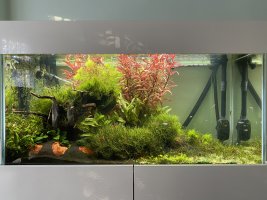 CA076C4D-33DE-435B-972A-8E8F0BB09D25.jpeg4 MB · Views: 165
CA076C4D-33DE-435B-972A-8E8F0BB09D25.jpeg4 MB · Views: 165 -
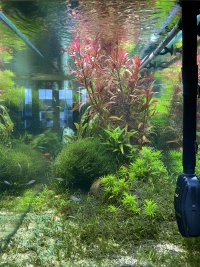 CB509F60-1FE3-4491-85F9-8D8301752BD6.jpeg3 MB · Views: 175
CB509F60-1FE3-4491-85F9-8D8301752BD6.jpeg3 MB · Views: 175 -
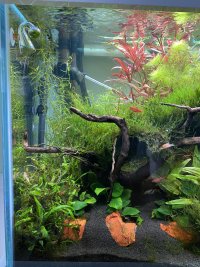 7D132D21-0347-4088-B668-52C916540478.jpeg2.7 MB · Views: 173
7D132D21-0347-4088-B668-52C916540478.jpeg2.7 MB · Views: 173 -
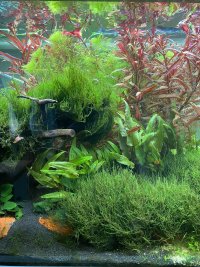 1AE91D5A-E148-4979-8FCA-A9B5AB1A9613.jpeg3 MB · Views: 157
1AE91D5A-E148-4979-8FCA-A9B5AB1A9613.jpeg3 MB · Views: 157 -
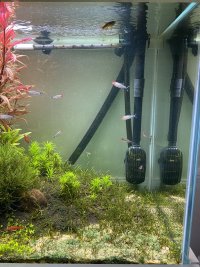 F84B3EB0-3E8E-4D75-B08C-54535CAFABBA.jpeg2.6 MB · Views: 167
F84B3EB0-3E8E-4D75-B08C-54535CAFABBA.jpeg2.6 MB · Views: 167 -
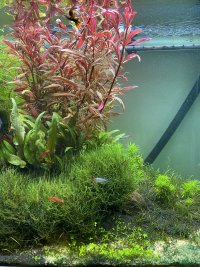 F6E240EA-69A9-4A11-B0D6-7C8740ACE224.jpeg3 MB · Views: 163
F6E240EA-69A9-4A11-B0D6-7C8740ACE224.jpeg3 MB · Views: 163


